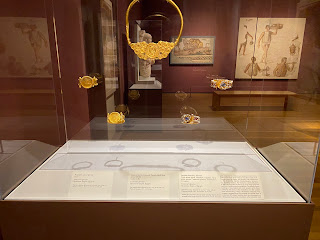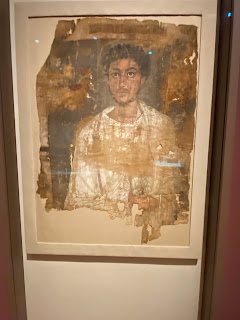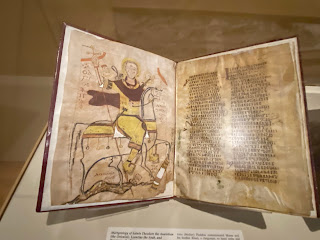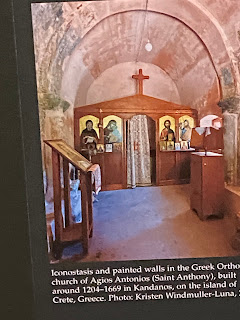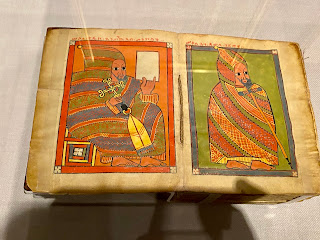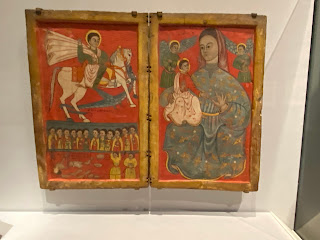AFRICA & BYZANTIUM
Cleveland Museum of Art
16 May 2021
Having read about a special exhibition, Africa and Byzantium, that was to be in NYC and being very interested in seeing it, I looked for other venues in the US. The only other venue I found was Cleveland, Ohio. I decided to make a short trip there to view the exhibition. The museum opened at 10am, and I was the first person to enter the exhibition that day. I asked if photos were allowed and was told, "Yes. Without flash." I had the space to myself until I was about three quarters of the way through.
About 3 centuries after the Egyptian Pharaohs ended their rule, new African rulers built empires in the north and east of Africa. From Ethiopia, Eritrea and Yemen to the Christian kingdoms of Nubia and Sudan, these kingdoms shared relationships with each other and with the Byzantine Empire, Rome's heir. They created their own arts and built a shared visual culture in the area. The arts and faiths of these kingdoms--Christianity, Judaism, Islam--still have a worldwide impact. The exhibition showed the relationships between the African kingdoms and the Byzantine Empire from about 300AD forward. Rulers of the kingdoms not only requested local artists to create artwork but also imported it from other areas. Each artwork dealt with a Christian subject through different techniques, materials, and/or styles. Artists often copied or adapted objects with a local flair. There were differences. Byzantine artists could make sculptures and figureheads, while Ethiopian were forbidden sculptures as graven images.
Diptych with Twelve Apostles and Saint Paul (about 1700AD) - Ethiopia
Captions in Ce'ez, an East African language identify each by name
Mosaic of a lady from Tunisia
Mosaic Epitaph (375AD-425AD)
Mosaic Funerary Description (375AD-425AD)
Wall Painting of the Virgin and Child (700AD)
Curtains of linen and wool (500AD-600AD)
Fragment of Three Figures framed by a Jeweled Border (450AD-550AD)
The wool and linen weaving had so deteoriated that the third figure on the left had disappeared so that portion was removed.
Woven Fragment of Satyr and Manead (300AD)
Nerrid or Sea Nymph (300AD-400AD)
Woven of linen and wool
Bronze Lamp (after 100AD) and Bronze Head Shaped Perfume or Incense Holder (100AD-200AD(
Funerary Panel of a Man (138AD-92AD) painted with wax on linen and then heat fused.
Funerary Panel of a Young Girl (25AD-37AD)
Gold Jewelry (539AD-700AD)
When Rome, and subsequently Byzantium, conquered northern Africa, it was not a barren wasteland. Vibrant civilizations located there contributed to the arts. For almost 700 years, some of their most important provinces were the so-called "breadbasket" in northern Africa. Trade was strong fueled in part by a desire for ivory and gold. From about 284AD to 641AD, there were diverse learning centers across the region. Some early Christian theologians came from the North African and Nile Valley communities. Monasticism arose from Egypt. There were conflicts, of course, between indigenous religions and Christianity and between different Christian sects.
Possibly Artemis and Actaeon (400AD-600AD) depicted on a linen and wool weaving.
Funerary Figure of a Woman (200AD-300AD)
Painting of a Woman showing Egyptian and Greek Influence
Mosaic: Lion Attaching Onager (150AD-200AD)
Mosaic: Enslaved Men Preparing for a Feast (late 100sAD)
Various Glass Objects
From about 241AD to 641AD, communities across the Mediterranean, Nile, and Saharan regions shared the experiences of becoming Christian. Emperor Ezana of the Aksumite Empire (Ethiopia, Eritrea, Djibouti, Sudan, Yemen) in northern Africa converted in 330AD and made Christianity the faith of the empire. Emperor Theodosius followed suit in Byzantium in 380AD.
Nubian metalwork Oil Lamp
Terracotta Pilgrim's Flasks (400AD-600AD) with image of Saint Means, a Roman soldier martyred for his faith around 300AD
Lamp Molds with Christogram (500AD) and Oil Lamp with Christogram and the Heads of the Apostles (400AD)
Oil Lamp with Cross & Birds (500AD); Oil Lamp with Angel (500AD-600AD; Oil Lamps with Menorah and Christ Crushing the Serpent's Head (500AD)
Made in Nubia (Sudan)
Toilet Box of wood and ivory (100BC-300AD) & Box of wood, ivory and bronze (300AD-500AD)
Both from Nubia (Sudan)
Wall Painting with Holy Men and a Coptic Inscription (500AD-600AD)
Saints Cosmas & Damian and 3 Hebrew Children
Woven wool Icon of the Virgin and Child (500AD)
Icon with the Virgin and Child, Saints, Angels and the Hand of God (500sAD)
Wood and Ivory Bridal Chest (300AD-500AD)
Enconium on the Four Bodiless Beasts (892AD-893AD) by Ape (Father) Isaac of Petouhar, Egypt
Homily on God's Mercifulness and the Freedom of Speech of Saint Michael Archangel (902AD-903AD) by Deacon Gabri of Egypt
Martyrology of Saints Theodore the Anatolian, Leontius the Arab, and Panigerus the Persian
(After 867AD) by Moses and Khan from Toul
Ink on Parchment (913AD-914AD)
Bible with Ancient Binding (822AS-914AD)
Christian Topography of the Cosmos (1000sAD)
Africa has a long history of repositories of important objects. Egypt's Great Library of Alexandria might be the ancient world's most well-known. However, monasteries, royal treasuries, churches, mosques, and synagogues had storerooms to safeguard and showcase important objects. Saint Catherine's Monastery in Sinai was established in 565AD.
Many people spoke multiple languages. The engraved monument in this illustration is a library of sorts. It has three languages: Coptic (Christian Egypt); Ce'ez (Empire of Ethiopia); Arabic (Egypt).
Letter to the Superiors of the Monastery of Saint Paul the Anchorite (September 13, 698AD)
Ink on papyrus
Detail from the Above Letter
Plan of Dayr al-Suryan, Wadi ai-Natrum built in early 700sAD
Plan drawn by William J. Jones in early 1900sAD
Photo of the Iconostasis and painted walls in the Greek Orthodox Church of Agios Antonios
Built between 1204 and 1699 on Crete
Icon of the Mother of God and Infant Child--Virgin Eleousa--(about 1425AD-1450AD)
Attributed to Angelos Akotantos
After about 175 years in North Africa and about 300 years in Egypt, the Byzantine Empire lost territory. Muslim states took its place and cultivated religious diversity and artistic creativity. This did not prevent the Christian communities in that area from remaining somewhat connected with Byzantium.
Portrait of Saint Luke (1440AD-1480AD) - Ethiopia
Diptych with Saint George (Ethiopia) and the Virgin Elousa (Crete) - about 1500 AD
Panel Painting with eh Crowned Nursing Virgin and the Twelve Apostles (1400sAD) - Ethiopia
In 610AD Islam emerged in Arabia and quickly became known to nearby North African societies. At the request of the Prophet Mohammad, the Christian Emperor in Ethiopia gave refuge to Muslims fleeing persecution in 613AD. Following the Prophet's death in 632AD, Muslim armies swept across Egypt and North Africa and conquered the lands. Islam considers both Christians and Jews as fellow "People of the Book," citing their shared texts and prophets. Under Islamic rule, these protected groups could freely worship, study, trade, and manage affairs according to their own legal and religious codes.
Candlestick Base (1200-1300) - Egypt
Fragment of a Woodblock Print on Linen (1200sAD-1300sAD) - Egypt
Cap with Striped Inscribed Silk (1300sAD) - Egypt or Syria
Jewish people have lived in Northern Africa from at least 1000BC sharing cultures with different faiths. Sometimes they were accepted and other times they were persecuted. Later Byzantine Imperial Rules restricted Jews' religious and political and often services were held in secret. Encouraged by medieval Islamic Egypt's religious tolerance, Old Cairo became a center for Jewish life.
Fragment of a [Jewish] Marriage Contract (1551AD) - Egypt
Stamps or Seals
Dedicatory Inscription from the Ben Ezra Synagogue (1220AD) - Egypt
Nubia, modern Sudan, gradually adopted Christianity from the 500sAD. This brought them into a relationship with Byzantium. In the 600sAD, Nubian forces resisted the Arab Muslim invasion. The peace treaty guaranteed religious autonomy. In addition to Coptic and Greek, they developed their own written language, Old Nubian.
Top Left: Document in Old Nubian (800sAD-900sAD); Bottom Left: Ostracon [piece of pottery used to write on] (500sAD); Top Right: Document in Old Nubian (1100sAD); Bottom Right: Flask with Bilingual Psalms (1000sAD-1300sAD): Center: Benedictal Cross (1300sAD)
Wall Painting with Bishop Petrus Protected by Saint Peter (late 900sAD) - Sudan
Wall Painting with a Nubian Dignitary Protected by Christ (mid-1100sAD) - Sudan
About 1500AD, Ethiopian Christians began building round churches with a square sanctuary in the center and the choir around it. There is an ambulatory forming the outer ring. Congregations stand just as they do in Orthodox Churches.
Processional Cross (1600sAD) - Ethiopia
Healing Scrolls (1700sAD-1800sAD)
Contain spells for healing and often refer to saints
Virgin and Child in Front of the Basilica of Santa Maria Maggiore (1500sAD) - Belgium
Wall Painting with Abba Antunes (Saint Anthony the Great) Receiving the Cup and Scapula (late 1600s) -Ethiopia
Wall Painting with Saints Takla Haymanot and Ewostatewos (about 1700AD) - Ethiopia
Wall Painting with Saint Filataivos (late 1600sAD) - Ethiopia
Wall Painting of a Saint Susanna and her Persecutors [left] and a Priest of Heaven [right]
(1600sAD) - Ethiopia
Triptych with Virgin and Child, Saints, and Scenes from the Life of Christ (1500sAD) - Ethiopia
Triptych with Virgin and Child, Apostles, and Scenes from the Life of Christ (about 1600AD) - Ethiopia
Triptych with Saint Ewostatewos and Eight of His Disciples (late 1600sAD) - Ethiopia
Ethiopic Prayer Book (1600sAD) - Ethiopia
Arganona Maryam [Prayer Book] (late 1600sAD) - Ethiopia
Taammera Maryam (late 1600sAD) - Ethiopia
Double Diptych Pendant: Saint George; Mary and the Christ Child; the Harrowing of Hell; the Crucifixion (early 1700sAD) - Ethiopia
Photo of Priest standing in front of the 17th century wall paintings at the Church of Dabra Sina Gorgora, Ethiopia
The following 3 photos show 3 sides of a painted wooden Chalice Case (mid-1700sAD) - Egypt
















